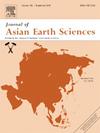Petrogenesis and geodynamic implications of gabbroic diorites of the early Paleozoic Mijiashan ophiolite in the eastern North Qilian Orogenic Belt, NW China
IF 2.7
3区 地球科学
Q2 GEOSCIENCES, MULTIDISCIPLINARY
引用次数: 0
Abstract
The early Paleozoic North Qilian Orogenic Belt (NQOB) records a complex history, from early oceanic subduction and back-arc extension to the eventual closure of the ocean and continental collision. The tectonic nature of the back-arc basin and its evolution are debated. The Mijiashan (MJS) ophiolite in the eastern NQOB is thought to represent remnants of the North Qilian back-arc, and consists mainly of a crustal sequence of basalts, plagiogranites, and gabbroic intrusions. A fine-grained gabbroic diorite intrusion has recently been identified in this crustal sequence. We present new zircon U–Pb ages and bulk-rock chemical and Sr–Nd isotopic data for these rocks. Zircon grains from the gabbroic diorite yield a U–Pb age of 510 Ma, which is taken to be the crystallization age of the rocks, consistent with the field relationship. The diorite is tholeiitic in composition, enriched in Cs, Ba, Sr, and Pb, and depleted in Nb, Ta, Th, and Rb on a primitive-mantle-normalized trace element spider diagram. It has low total rare earth element (REE) contents and yields chondrite-normalized rare earth element patterns depleted in light REEs. The MJS gabbroic diorite has depleted isotopic compositions [whole-rock εNd(t) = +4.96 to + 5.25; initial 87Sr/86Sr ratio = 0.7055–0.7066]. These geochemical and isotopic characteristics suggest that these rocks were formed from melts that were derived from partial melting of residual, extremely refractory, hydrated mantle peridotite. This mantle wedge source had previously experienced the extraction of MORB-type melts and was subsequently metasomatized primarily by subduction-derived fluids, with minimal contributions from seafloor sediment components. The gabbroic diorite of the MJS ophiolite was formed in an intracontinental back-arc setting and represents the earliest identified magmatic record of the initiation of arc rifting in a supra-subduction zone environment in response to rollback of the northward-subducting North Qilian oceanic lithosphere.

求助全文
约1分钟内获得全文
求助全文
来源期刊

Journal of Asian Earth Sciences
地学-地球科学综合
CiteScore
5.90
自引率
10.00%
发文量
324
审稿时长
71 days
期刊介绍:
Journal of Asian Earth Sciences has an open access mirror journal Journal of Asian Earth Sciences: X, sharing the same aims and scope, editorial team, submission system and rigorous peer review.
The Journal of Asian Earth Sciences is an international interdisciplinary journal devoted to all aspects of research related to the solid Earth Sciences of Asia. The Journal publishes high quality, peer-reviewed scientific papers on the regional geology, tectonics, geochemistry and geophysics of Asia. It will be devoted primarily to research papers but short communications relating to new developments of broad interest, reviews and book reviews will also be included. Papers must have international appeal and should present work of more than local significance.
The scope includes deep processes of the Asian continent and its adjacent oceans; seismology and earthquakes; orogeny, magmatism, metamorphism and volcanism; growth, deformation and destruction of the Asian crust; crust-mantle interaction; evolution of life (early life, biostratigraphy, biogeography and mass-extinction); fluids, fluxes and reservoirs of mineral and energy resources; surface processes (weathering, erosion, transport and deposition of sediments) and resulting geomorphology; and the response of the Earth to global climate change as viewed within the Asian continent and surrounding oceans.
 求助内容:
求助内容: 应助结果提醒方式:
应助结果提醒方式:


